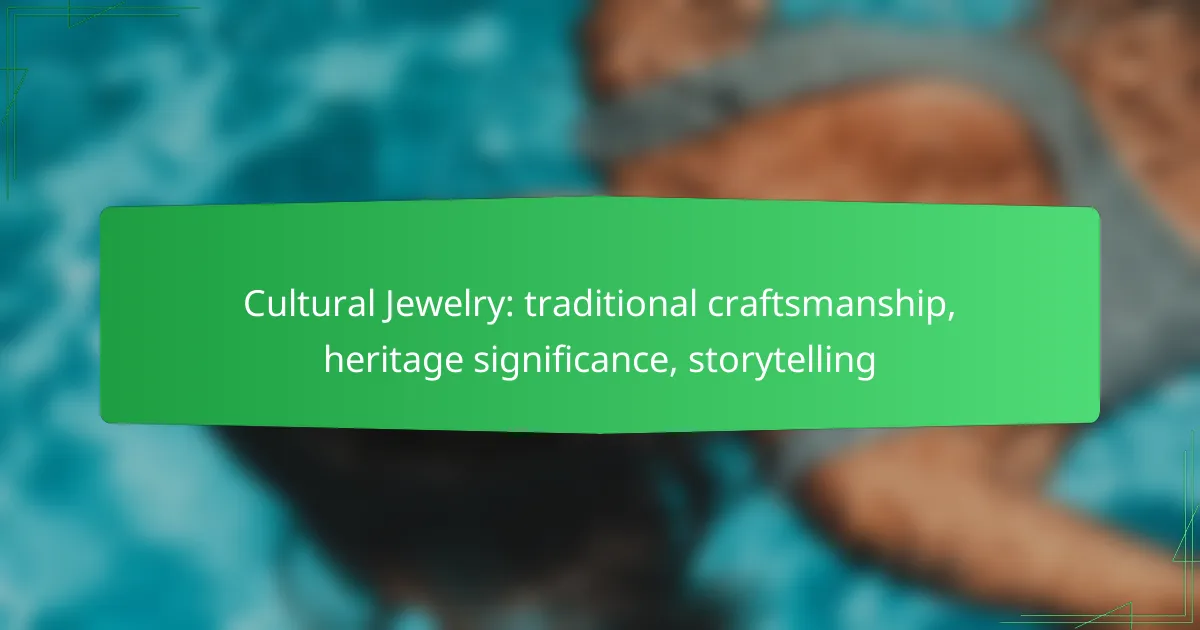Cultural jewelry serves as a vibrant expression of heritage, showcasing unique designs and craftsmanship that narrate the stories of history and identity. Each piece reflects regional traditions and personal narratives, emphasizing the importance of traditional techniques and local materials in preserving cultural significance.

How does cultural jewelry reflect heritage in the UK?
Cultural jewelry in the UK embodies heritage through its unique designs, materials, and craftsmanship that tell stories of history and identity. Each piece often represents regional traditions, social status, and personal narratives, making it a vital aspect of cultural expression.
Symbolism of traditional designs
Traditional jewelry designs in the UK are rich with symbolism, often reflecting significant cultural beliefs and values. For example, Celtic knots represent eternity and interconnectedness, while specific motifs may signify protection or love. These designs serve not only as adornments but also as carriers of stories and cultural heritage.
Moreover, the use of materials like silver, gold, and gemstones often has specific meanings tied to local folklore or historical events. Wearing such pieces can evoke a sense of pride and connection to one’s ancestry.
Regional variations in craftsmanship
The craftsmanship of cultural jewelry varies significantly across different regions of the UK, influenced by local traditions and available resources. In Scotland, for instance, you might find intricate silver work inspired by the natural landscape, while Welsh jewelry often features unique designs like the lovespoon motif, symbolizing love and affection.
Artisans in Northern Ireland may focus on using local stones and traditional techniques, while English jewelry often showcases a blend of historical influences and contemporary styles. Understanding these regional variations can enhance appreciation for the artistry and significance behind each piece.

What are the key features of traditional craftsmanship?
Traditional craftsmanship is characterized by its emphasis on handmade techniques, the use of local materials, and a deep connection to cultural heritage. These features not only enhance the uniqueness of each piece but also tell stories that reflect the history and values of the community.
Handmade techniques
Handmade techniques are central to traditional craftsmanship, often involving skills passed down through generations. Artisans typically use tools that have been in their families for years, allowing them to create intricate designs that machines cannot replicate.
Common methods include hand engraving, weaving, and casting, each requiring significant time and expertise. For example, traditional jewelry may involve techniques like filigree, where fine threads of metal are twisted and shaped by hand to form delicate patterns.
Use of local materials
The use of local materials is a hallmark of traditional craftsmanship, ensuring that each piece is not only authentic but also sustainable. Artisans often source materials such as gemstones, metals, and textiles from their immediate environment, which helps to support local economies.
For instance, in regions known for their specific minerals, jewelry may feature stones that are unique to that area, enhancing the cultural significance of the piece. This practice not only preserves local resources but also connects the jewelry to the land and its stories.

How can I identify authentic cultural jewelry?
To identify authentic cultural jewelry, look for indicators such as certification from recognized artisans and the provenance of the piece. These elements not only confirm authenticity but also highlight the craftsmanship and cultural significance behind the jewelry.
Certification from recognized artisans
Authentic cultural jewelry often comes with certification from skilled artisans who are recognized within their communities. This certification can take the form of a hallmark, a certificate of authenticity, or documentation that outlines the artisan’s background and the techniques used.
When purchasing, inquire about the artisan’s credentials and their connection to the cultural heritage represented in the jewelry. Reputable sources will provide clear information about the artisan’s training and experience, which can help you assess the authenticity of the piece.
Provenance and storytelling
The provenance of cultural jewelry refers to its history and the stories associated with it. Authentic pieces often come with narratives that explain their significance, including the cultural practices they represent and the materials used in their creation.
Look for jewelry that includes details about its origin, such as the region it comes from and the traditional methods employed in its crafting. This storytelling aspect not only enhances the value of the jewelry but also connects you to the cultural heritage it embodies.

What are the best cultural jewelry brands in the UK?
Some of the best cultural jewelry brands in the UK emphasize traditional craftsmanship and heritage significance, offering pieces that tell unique stories. These brands often incorporate local materials and techniques, making their jewelry not just accessories but also representations of cultural identity.
Folklores by Asha
Folklores by Asha specializes in handcrafted jewelry that draws inspiration from various cultural narratives and folklore. Each piece is designed to reflect the stories and traditions of different communities, often using ethically sourced materials.
The brand is known for its vibrant colors and intricate designs, which resonate with the rich heritage of the cultures it represents. Customers appreciate the personal touch and the storytelling aspect embedded in every item.
Silver Tree Jewelry
Silver Tree Jewelry focuses on sustainable practices while celebrating traditional craftsmanship. This brand offers a range of silver jewelry that features designs inspired by nature and folklore, making each piece a conversation starter.
With a commitment to ethical sourcing, Silver Tree Jewelry ensures that its materials are responsibly obtained, which appeals to environmentally conscious consumers. The brand’s unique designs often incorporate symbols that hold cultural significance, adding depth to each item.

How does cultural jewelry tell a story?
Cultural jewelry conveys narratives through its designs, materials, and craftsmanship, reflecting the heritage and traditions of a community. Each piece often embodies historical significance, personal stories, and cultural values, making it a powerful medium for storytelling.
Inspiration from folklore
Cultural jewelry frequently draws inspiration from local folklore, incorporating symbols and motifs that represent myths, legends, and traditional tales. For example, in many Indigenous cultures, jewelry may feature designs that depict animals or natural elements significant to their creation stories.
This connection to folklore not only preserves these narratives but also allows wearers to express their identity and cultural pride. By wearing such pieces, individuals can share their heritage and the stories that shape their community’s history.
Personal narratives through design
Jewelry can also reflect personal experiences and milestones, making it a canvas for individual storytelling. For instance, a piece might be crafted to commemorate a significant life event, such as a wedding or a birth, using specific gemstones or designs that hold personal meaning.
When selecting or designing cultural jewelry, consider how the elements resonate with your own story. This approach not only enhances the emotional value of the piece but also fosters a deeper connection between the wearer and their cultural roots.

What are the benefits of purchasing cultural jewelry?
Purchasing cultural jewelry offers numerous benefits, including supporting local artisans and preserving unique cultural heritage. These pieces often carry deep meanings and stories, making them not just accessories but also valuable representations of tradition.
Supporting local artisans
Buying cultural jewelry directly supports local artisans, helping them sustain their craft and livelihoods. This financial support enables artisans to continue their traditional methods, which may have been passed down through generations.
When you choose to purchase from local creators, you often receive handmade items that reflect the authenticity and uniqueness of the culture. This not only enriches your collection but also fosters a sense of community and connection with the artisans.
Preserving cultural heritage
Cultural jewelry plays a crucial role in preserving the heritage of various communities. Each piece often embodies traditional techniques, symbols, and stories that are significant to a particular culture, ensuring that these elements are not lost over time.
By purchasing and wearing cultural jewelry, you contribute to the ongoing appreciation and recognition of these traditions. This act helps keep the stories alive, allowing future generations to understand and value their cultural roots.

How do I choose cultural jewelry as a gift?
Choosing cultural jewelry as a gift involves understanding the recipient’s heritage and personal style. Consider the significance of the piece, its craftsmanship, and how it tells a story that resonates with the individual.
Understand the cultural significance
Each piece of cultural jewelry often carries deep meanings and traditions. Research the specific culture associated with the jewelry, as symbols and materials can represent various values, beliefs, or historical narratives.
For example, Native American jewelry may incorporate turquoise, which symbolizes protection and healing, while African tribal pieces might use beads that signify status or community ties. Knowing these meanings can help you select a piece that honors the recipient’s background.
Consider craftsmanship and materials
The craftsmanship and materials used in cultural jewelry can greatly affect its value and appeal. Look for handmade items that showcase traditional techniques, as these often reflect the skill and artistry of the culture.
Materials like gold, silver, or specific gemstones can also indicate quality and significance. For instance, in Indian culture, gold jewelry is highly valued and often worn during festivals and weddings, making it a meaningful gift.
Think about personal style
While cultural significance is important, the recipient’s personal style should also guide your choice. Consider their preferences in color, design, and type of jewelry—whether they prefer earrings, necklaces, or bracelets.
For example, if they lean towards minimalist designs, a simple silver pendant with cultural motifs might be ideal. Conversely, if they enjoy bold statements, a vibrant beaded necklace could be more suitable.
Set a budget
Establishing a budget is crucial when selecting cultural jewelry. Prices can vary widely based on materials, craftsmanship, and cultural significance. Determine a comfortable range to avoid overspending while still finding a meaningful piece.
For instance, you might find quality cultural jewelry starting from around $50 for simpler pieces, while intricate, handcrafted items can reach several hundred dollars or more. Balancing quality and budget will help ensure a thoughtful gift.
